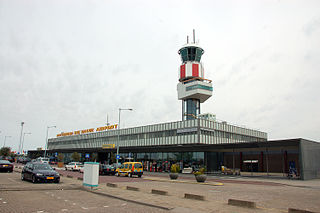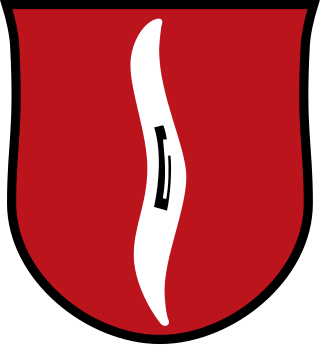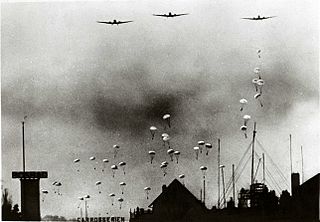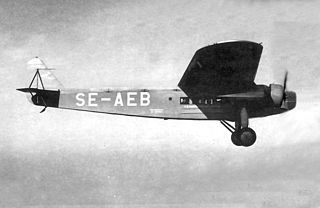
N.V. Koolhoven was an aircraft manufacturer based in Rotterdam, Netherlands. From its conception in 1926 to its destruction in the Blitzkrieg in May 1940, the company remained the second major Dutch aircraft manufacturer. Although many of its aircraft were as unsuccessful economically as they were brilliant from a design standpoint, the company managed to score several 'hits', amongst them the FK-58 single-seat monoplane fighter, the FK-50 twin-engine passenger transport, and the FK-41, built in England under licence by Desoutter.
The Netherlands entered World War II on May 10, 1940, when invading German forces quickly overran the country. On December 7, 1941, after the attack on Pearl Harbor, the Netherlands government in exile also declared war on Japan. Operation Market Garden, which started in 1944, liberated the southern and eastern parts of the country, but full liberation did not come until the surrender of Germany on May 5, 1945.

Rotterdam The Hague Airport, is a minor international airport serving Rotterdam, the Netherlands' second largest city, and The Hague, its administrative and royal capital. It is located 3 NM north northwest of Rotterdam in South Holland and is the third busiest airport in the Netherlands.

The Fokker G.I was a Dutch twin-engined heavy fighter aircraft comparable in size and role to the German Messerschmitt Bf 110. Although in production prior to World War II, its combat introduction came at a time the Netherlands were overrun by the Germans. The few G.Is that were mustered into service were able to score several victories. Some were captured intact after the Germans had occupied the Netherlands. The remainder of the production run was taken over by the Luftwaffe for use as trainers.

Johan Adolf Pengel International Airport, also known as Paramaribo-Zanderij International Airport, and locally referred to simply as JAP, is an airport located in the town of Zanderij and hub for airline carrier Surinam Airways, 45 kilometres (28 mi) south of Paramaribo. It is the larger of Suriname's two international airports, the other being Zorg en Hoop with scheduled flights to Guyana, and is operated by Airport Management, Ltd./ NV Luchthavenbeheer.

Operation Manna and Operation Chowhound were humanitarian food drops, carried out to relieve a famine in the German-occupied Netherlands, undertaken by Allied bomber crews during the final days of World War II in Europe. Manna, which dropped 7000 tonnes of food into the still Nazi-Occupied western part of the Netherlands, was carried out by British RAF units, as well as squadrons from the Australian, Canadian, New Zealand and Polish air forces. Chowhound, which dropped 4000 tonnes, was undertaken by the United States Army Air Forces, for a total of over 11,000 tonnes of food. This was done with the acquiescence of the occupying German forces, to help feed Dutch civilians in danger of starvation.

The German invasion of the Netherlands, otherwise known as the Battle of the Netherlands, was a military campaign part of Case Yellow, the Nazi German invasion of the Low Countries and France during World War II. The battle lasted from 10 May 1940 until the surrender of the main Dutch forces on 14 May. Dutch troops in the province of Zeeland continued to resist the Wehrmacht until 17 May when Germany completed its occupation of the whole country.

HNLMS Johan Maurits van Nassau, named after John Maurice of Nassau, was a Dutch gunboat that served in the early part of World War II, when it was sunk. She was the sole ship of her class, which was developed from the earlier Flores class.

Charlois is a neighbourhood of the Dutch city of Rotterdam. It is located on the south bank of the Nieuwe Maas.

Kampfgeschwader 4 "General Wever" was a Luftwaffe bomber wing during World War II. The unit was formed in May 1939. The unit operated the Dornier Do 17, Junkers Ju 88 and Heinkel He 111 medium bombers, with later service on the Heinkel He 177 heavy bomber. The wing was named after General Walther Wever, the prime pre-war proponent for a strategic bombing capability for the Luftwaffe, who was killed in an aircraft accident in 1936.

The Battle for The Hague was a battle fought on 10 May 1940 during the Battle of the Netherlands. German Fallschirmjäger units were dropped in and around The Hague to capture Dutch airfields and the city itself.

The Battle of Rotterdam was a Second World War battle fought during the Battle of the Netherlands. Fought between 10 and 14 May 1940, it was a German attempt to seize the Dutch city. It ended in a German victory, following the Rotterdam Blitz.

Frederick (Frits) Koolhoven was an aircraft designer in Britain and his native Netherlands.

The former Van Nelle Factory on the Schie in Rotterdam, is considered a prime example of the International Style based upon constructivist architecture. It has been a designated UNESCO World Heritage Site since 2014. Soon after it was built, prominent architects described the factory as "the most beautiful spectacle of the modern age" and "a poem in steel and glass".
The KPN-Zendmast Waalhaven, also known as Communication Tower, is a 191.5 metres (628 ft) self-supporting telecommunications tower located in Rotterdam in the Netherlands that was built in 1962. It is the tallest structure in Rotterdam and one of the tallest structures in the Netherlands. The tower is made of reinforced concrete with a metal transmitter at the top and at least one observation deck about halfway up.

The 1927 KLM Fokker F.VIII crash happened on 22 August 1927 when Fokker F.VIII H-NADU of KLM crashed at Underriver, Kent, following structural failure of the tailfin or rudder. The aircraft was operating an international scheduled flight from Croydon, Surrey, to Waalhaven Airport, Rotterdam, the Netherlands. One of the two crew was killed and eight people were injured.

Heijplaat is a neighborhood of Rotterdam, Netherlands.
The Shipping and Transport College Group is an international maritime transport and logistics education provider, which also offers consultancy and applied research in the field of shipping, ports, transport, logistics and port-related oil and chemical activities. The group has a number of schools and training centers worldwide and offers both master's/bachelor's degrees and vocational diplomas. The group's headquarters is located in Rotterdam, the Netherlands.
Crooswijk General Cemetery is a cemetery in Rotterdam, the Netherlands.

HNLMS Van Galen was a Admiralen-class destroyer of the Royal Netherlands Navy, named after the 17th century Dutch Commodore Johan van Galen. She served during World War II. The opening chapter of E.H.Larive's autobiography 'The Man Who Came In From Colditz' describes in detail the craft's demise.
















